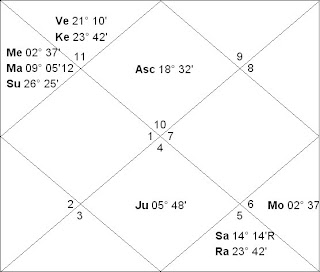Let us take up two illustrations. The individual of the chart was born on 02 August 1951 at 2325 hours at 28 degrees North 39  minutes latitude and 77 degrees East 13 minutes longitude. The place of birth is 0530 hours east of GMT. The ascendant is in Aries and the fifth house has Leo. She had a son born to her on 2 November 1991. The major-period of Venus was going on. On the day of birth of the child the Sun was in exchange of sign with Venus in Libra, Venus being in Leo, and Mars was associated with the Sun. Jupiter on that day was in Leo with Venus.
minutes latitude and 77 degrees East 13 minutes longitude. The place of birth is 0530 hours east of GMT. The ascendant is in Aries and the fifth house has Leo. She had a son born to her on 2 November 1991. The major-period of Venus was going on. On the day of birth of the child the Sun was in exchange of sign with Venus in Libra, Venus being in Leo, and Mars was associated with the Sun. Jupiter on that day was in Leo with Venus.
 minutes latitude and 77 degrees East 13 minutes longitude. The place of birth is 0530 hours east of GMT. The ascendant is in Aries and the fifth house has Leo. She had a son born to her on 2 November 1991. The major-period of Venus was going on. On the day of birth of the child the Sun was in exchange of sign with Venus in Libra, Venus being in Leo, and Mars was associated with the Sun. Jupiter on that day was in Leo with Venus.
minutes latitude and 77 degrees East 13 minutes longitude. The place of birth is 0530 hours east of GMT. The ascendant is in Aries and the fifth house has Leo. She had a son born to her on 2 November 1991. The major-period of Venus was going on. On the day of birth of the child the Sun was in exchange of sign with Venus in Libra, Venus being in Leo, and Mars was associated with the Sun. Jupiter on that day was in Leo with Venus. Let us take up a case of an accident. This woman was born on 10 April 1979 at 0315 hours at 47 degrees North 42 minutes latitude and 122 degrees West 54 minutes longitude. The place of birth is 0800 hours west of GMT. She had gone to another country where she met with a vehicular accident on 16 March 2003. She was experiencing the major-period of Rahu at that time. The ascendant has Capricorn and the sixth house is in Gemini. On the date of the accident Saturn was in Taurus with Rahu and Mercury was in Aquarius. Saturn and Mercury were thus in sambandha. Saturn was in Mrigsheersha constellation of Mars. Further, Mercury was in Poorvabhadrapada constellation of Jupiter, and the latter was in sambandha with Mars on the day of the accident.
Let us take up a case of an accident. This woman was born on 10 April 1979 at 0315 hours at 47 degrees North 42 minutes latitude and 122 degrees West 54 minutes longitude. The place of birth is 0800 hours west of GMT. She had gone to another country where she met with a vehicular accident on 16 March 2003. She was experiencing the major-period of Rahu at that time. The ascendant has Capricorn and the sixth house is in Gemini. On the date of the accident Saturn was in Taurus with Rahu and Mercury was in Aquarius. Saturn and Mercury were thus in sambandha. Saturn was in Mrigsheersha constellation of Mars. Further, Mercury was in Poorvabhadrapada constellation of Jupiter, and the latter was in sambandha with Mars on the day of the accident. Events take shape according to the operation of the houses and karakas. We will give some more illustrations in the next blog.
No comments:
Post a Comment